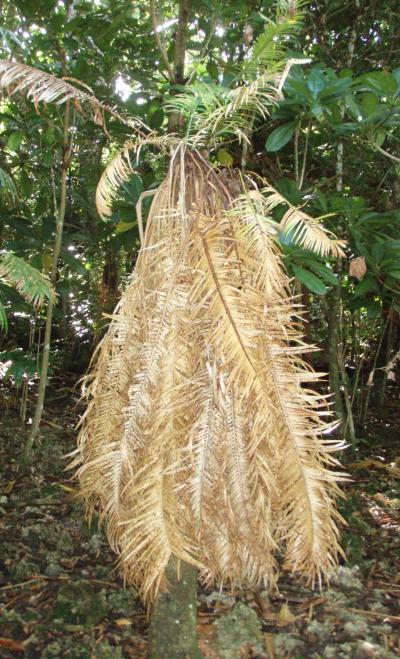Thomas Marler recently published the results of his research that reveal some of the attributes of the long-lived leaves of Guam’s Cycas micronesica plants. “These leaves are relatively large and are constructed of tough tissues,” said Marler. “Both of these factors indicate the construction costs of this leaf form are substantial.”
Green leaves must pay back their own construction costs, but each leaf is also required to supply the energy needed to maintain its live tissues throughout its lifespan. Additionally, large plants like Guam’s Cycas have an abundance of non-green tissue that requires energy to maintain. Therefore, large plants with this leaf construction strategy must also possess a payback strategy that allows recovery of these costs coupled with an excess in food synthesis to support plant growth.
“These phenomena are understood using a financial analogy where borrowing a modest amount of money for one investment strategy is much easier to pay back and less risky than borrowing a substantial sum of money for a different investment strategy,” said Marler. “The manufacture of food by the leaf is analogous to the income generated from the investments.”
Results of the research indicate these plants approach the substantial leaf construction investments by delaying the decline in food synthesis capacity that accompanies the leaf aging process. Many fast-growing species, for example, constantly replace their leaves. For these species, food synthesis may be reduced to negligible levels in less than one month after leaf construction. In contrast, the decline in food synthesis for leaves of Guam’s Cycas is minimal, with rates of two-year-old leaves sustained at 80% of the initial maximum. Marler indicates this sluggish pace of decline is 65-80 times slower than other species for which this trait has been determined.
The financial risk analogy illuminates a critical environmental issue because Guam’s Cycas population is being threatened by alien species that feed on its leaves. Guam’s alien deer and several alien insects halt a leaf’s payback process such that construction costs are not recovered before the leaves are eaten. As the process is repeated the plant effectively starves to death.
This work continues to propel forward the Cycas research that is based in Guam. The general lack of physiology research on Cycas species is a limitation to our understanding of this important plant group. Every comprehensive written text on Cycas makes a point of how little is known about how these plants function. Thomas Marler, through his work at the Western Pacific Tropical Research Center, is busy addressing this void in the literature.
References:
https://www.eurekalert.org/pub_releases/2009-07/uog-hcc072209.php




